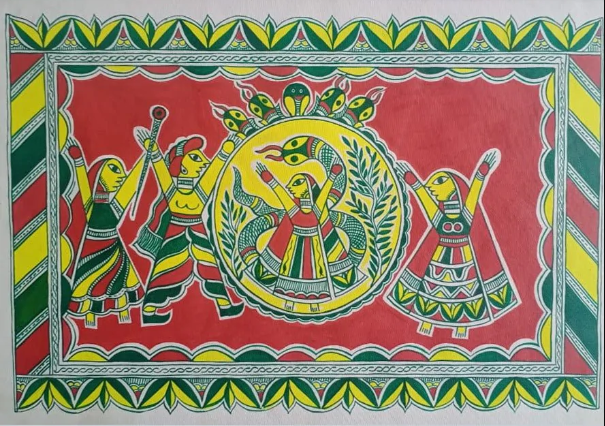Manjusha art has been prevalent in Bhagalpur for many years, but it gained significant prominence between 1931 and 1948. This period marked a resurgence and increased recognition of the art form. Manjusha art is notable for being one of the few art forms in India that presents a sequential story through pictorial representation, often referred to as scroll painting. Historically, Manjusha art was created in two distinct parts by different castes: the Kumbhakar caste shaped the pots or boxes on which the art was painted, while the Malakar caste was responsible for preparing and painting these Manjushas. This division of labor ensured the intricate art was faithfully produced and preserved.
The themes of Manjusha art primarily revolve around mythological stories and local legends. A common theme is the tale of Bihula, a devoted wife who saves her husband from a snake-bite and divine wrath, and Bishahari, also known as Mansa. These stories are depicted in a sequential manner across multiple panels, illustrating episodes from the narrative. The paintings often convey moral and religious lessons, making them not just artistic creations but also vehicles for storytelling and cultural preservation.
History
Manjusha art has been prevalent in Bhagalpur for many years, but it gained significant prominence between 1931 and 1948. This period marked a resurgence and increased recognition of the art form. Manjusha art is notable for being one of the few art forms in India that presents a sequential story through pictorial representation, often referred to as scroll painting. Historically, Manjusha art was created in two distinct parts by different castes: the Kumbhakar caste shaped the pots or boxes on which the art was painted, while the Malakar caste was responsible for preparing and painting these Manjushas. This division of labor ensured the intricate art was faithfully produced and preserved.
Materials and Methods
The materials used in Manjusha art include handmade paper or cloth for the canvas, and natural dyes extracted from plants and minerals for coloring. The process begins with the preparation of the surface, which is then lightly sketched with the design. Colors are applied in layers, with fine brushes used to achieve detailed patterns. The final step involves adding intricate details and embellishments to enhance the visual impact of the artwork. Traditionally, Manjusha art was painted on bamboo and jute boxes used in religious ceremonies, which adds a unique three-dimensional quality to the art.
Manjusha art is distinguished by its unique style, which includes detailed, repetitive patterns and vibrant colors. The art form utilizes natural dyes and pigments to achieve its rich color palette. The style is characterized by intricate designs that are meticulously applied to the surface, often incorporating geometric patterns, floral motifs, and mythological symbols. The sequential nature of Manjusha paintings, laid out in a scroll-like format, allows viewers to follow the narrative step by step, adding a dynamic element to the artwork.
Significance
Manjusha art holds significant cultural and historical value as it represents the rich folk traditions of Bihar. The sequential storytelling aspect of the art form makes it unique in the Indian art landscape, allowing for the narration of complex mythological tales through visual means. The art form not only preserves local folklore and religious stories but also reflects the artistic skills and cultural practices of the region. In contemporary times, Manjusha art continues to be a symbol of cultural pride and heritage, attracting attention from art enthusiasts and collectors worldwide. Efforts to promote and preserve Manjusha art contribute to the ongoing appreciation and relevance of this traditional craft.
Manjusha art is versatile and can be displayed in various ways, from framed wall art to decorative panels. Its bold colors and intricate patterns make it an eye-catching addition to any room, whether as a focal point or part of a gallery wall.
Yes, Manjusha art makes for a thoughtful and unique gift, especially for those who appreciate traditional Indian art forms. It carries cultural significance and can be a meaningful present for special occasions.
Yes, traditional Manjusha art uses natural dyes and eco-friendly colors, which are safe and sustainable. The artists follow age-old techniques to prepare these colors, ensuring that the art remains true to its roots.


